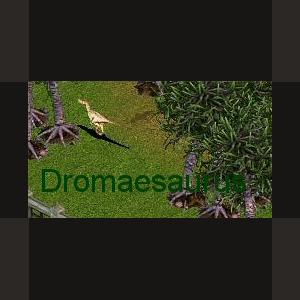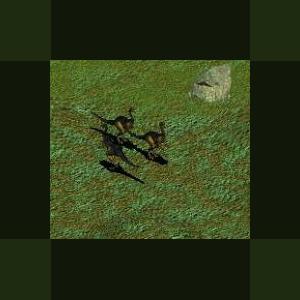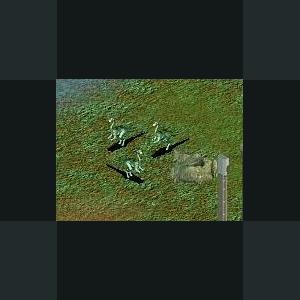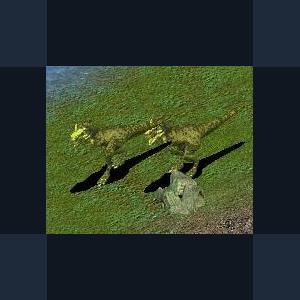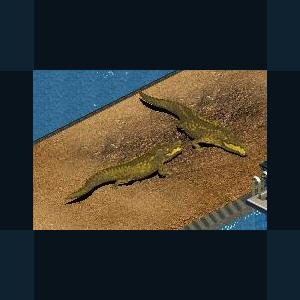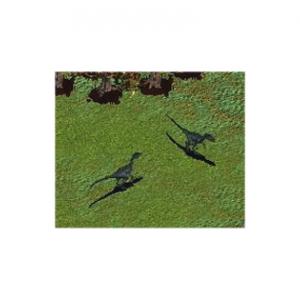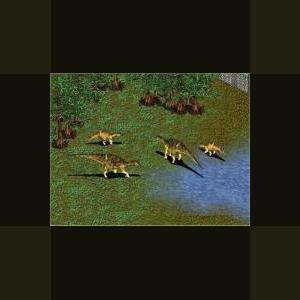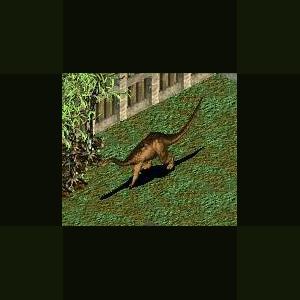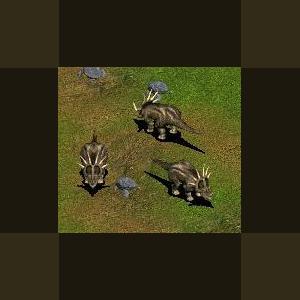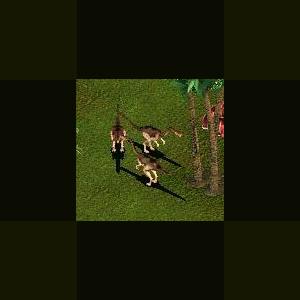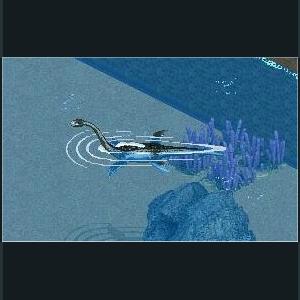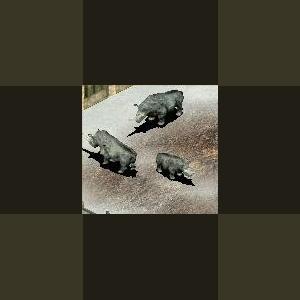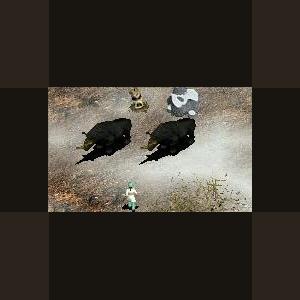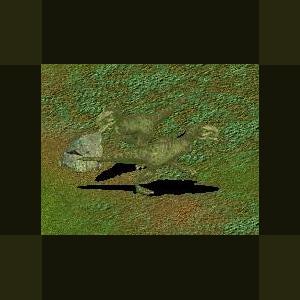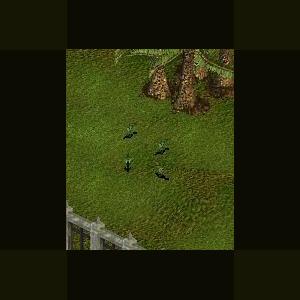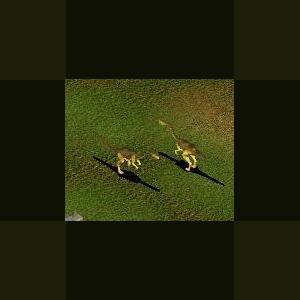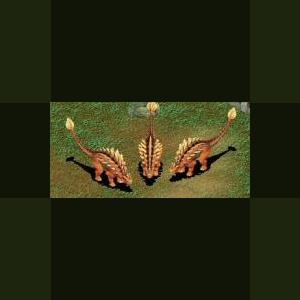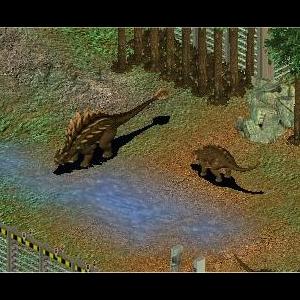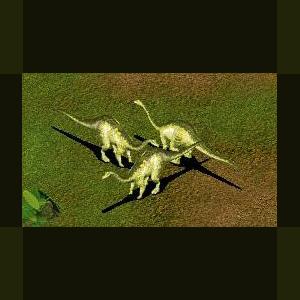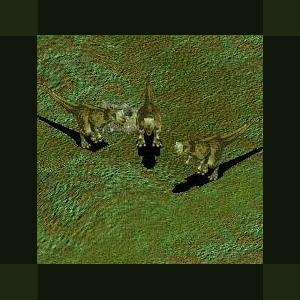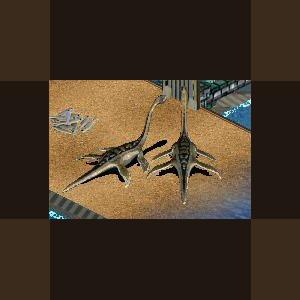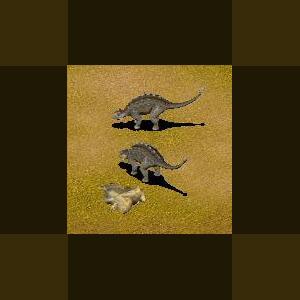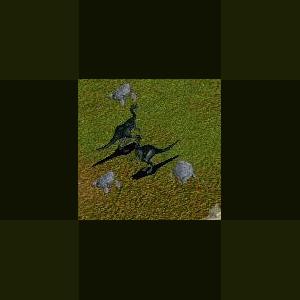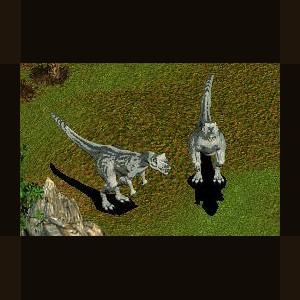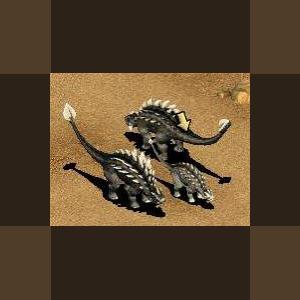Dinosaurs
Creatures from another age
241 files
-
Dromaeosaurus by Moondawg
By Guest
The first known Dromaeosaurus remains were first discovered by paleontologist Barnum Brown during a 1914 expedition to the Judith River Formation on behalf of the American Museum of Natural history. The area where these bones were collected is now part of Dinosaur Provincial Park in Alberta, Canada. The find consisted of a partial skull 9 inches in length and some foot bones. Several other bones, and dozens of isolated teeth, are also known from subsequent discoveries in Alberta and the western United States.[1]
Several species of Dromaeosaurus have been described, but Dromaeosaurus albertensis is the most complete specimen. Additionally, it is apparent that this genus is even rarer than other small theropods, although it was one of the first small theropods described based on reasonably good cranial material.
In 1969 similarities in anatomy between Dromaeosaurus and its relative Deinonychus were first observed. Based on the sickle-claws and commonalities in the skull, a new family, the dromaeosauridae was erected to house these two genera.[1] Since then, many new relatives of Dromaeosaurus have been found.
Dromaeosaurus differs from most other Dromaeosauridae in having a short, massive skull, a deep mandible, and robust teeth. In these respects Dromaeosaurus resembled the tyrannosaurs. The teeth tend to be more heavily worn than those of its relative Saurornitholestes, suggesting that its jaws were used for crushing and tearing rather than simply slicing through flesh.
It is possible that Dromaeosaurus was more of a scavenger than other small theropods, or it may be that Dromaeosaurus relied more heavily on its jaws to dispatch its prey. It was probably better suited to tackling large prey than the more lightly built Saurornitholestes.
The relationships of Dromaeosaurus are unclear. Although its rugged build gives it a primitive appearance, it was actually a very specialized animal. It is usually given its own subfamily, the Dromaeosaurinae; this group is thought to include Utahraptor, Achillobator, Adasaurus and perhaps Deinonychus.
However, the relationships of dromaeosaurs are still in a state of flux. "Dromaeosaurus Morphotype A" is the designation given to a series of unusual, ridged dromaeosaur teeth from Alberta. These teeth probably do not belong to Dromaeosaurus, although it is unclear from what animal they do come.
200 downloads
0 comments
Updated
-
Dromiceiomimus by Moondawg
By Guest
Dromiceiomimus (meaning "Emu mimic") was a swift bipedal dinosaur from the late Cretaceous period, about 80 to 65 million years ago
It was about 12 feet (3.5 m) long and weighed about 220 to 330 pounds (100 to 150 kg). Its femur (thigh bone) was 468 mm long. This ornithomimid (a bird-like theropod) had very long limbs, hollow bones, and a large brain and eyes. It had a toothless, beaked mouth, and weak jaws.
The brains of ornithomimids were large for dinosaurs, but this may not necessarily be a sign of greater intelligence; some paleontologists think that the enlarged portions of the brain were dedicated to kinesthetic coordination. Compared to other ornithomimosaurs Drimiceiomimus had a short back, long slender forearms, very large eye sockets, and pelvic bones that were arranged somewhat differently.
The first fossil remains of this genus were discovered in the 1920s, and originally named Struthiomimus brevitertius and S. samueli. It was renamed by Russell in 1972 to D. brevitertius after an extensive review of North American ornithomimosaurs, which he reclassified into three genera: Dromiceiomimus, Ornithomimus, and Struthiomimus. Alberta, Canada's Horseshoe Canyon and Judith River Formations have yielded fossils of both adults and juveniles. The top speed of this dinosaur is believed to be 40 mph.
167 downloads
0 comments
Updated
-
Dryosaurus by Moondawg
By Guest
Dryosaurus
Dryosaurus (DRY-oh-sawr-us) meaning 'oak lizard', due to the vague oak shape of its cheek teeth (Greek dryo meaning 'oak' and sauros meaning 'lizard') was a genus of an ornithopod dinosaur that lived in the Late Jurassic Period. It was an iguanodont (formerly classified as a hypsilophodont). Fossils have been found in the western United States and Tanzania and were first discovered in the late 19th century. The Tanzanian site proved to be an especially fertile hunting ground for Dryosaurus fossils, this specimen was previously called Dysalotosaurus (Lost wood reptile). An expedition led by German paleontologist Werner Janensch found a great many fossils that represented Dryosaurus at all stages of development.
Dryosaurus had a long neck, long, slender legs and a long, stiff tail. Its 'arms', however, with five 'fingers' on each 'hand', were short. It was about 8 to 14 feet (2.4 to 4.3 m) long, five feet (1.5 m) tall (at the hips) and weighed 170 to 200 pounds (77 to 91 kg). Its eyes were quite large, leading many to believe that it possessed excellent eyesight.
Dryosaurus had a horny beak and cheek teeth and, like other ornithopods, was a herbivore. Some scientists suggest that it had cheek-like structures to prevent the loss of food while the animal processed it in the mouth. It was probably a herd animal, which raised and protected its young after hatching.
A quick and agile runner with strong legs, Dryosaurus used its stiff tail as a counter-balance. It probably relied on its speed as a main defense against carnivorous dinosaurs.
Its intelligence, as measured by its brain-to-body ratio, was midway when compared to other dinosaurs.
226 downloads
0 comments
Updated
-
Dryptosaurus by Moondawg
By Guest
Dryptosaurus (meaning "tearing lizard") was a genus of primitive tyrannosaur that lived in Eastern North America during the Maastrichtian stage of the Late Cretaceous period.
An early painting of Dryptosaurus aquilunguis by Charles R. Knight illustrated fossil remains of Dryptosaurus aquilunguis. Dryptosaurus was 6.5 m long, 1.8 m high at the hips, and weighed about 1.2 tons. Like its relative Eotyrannus, it had relatively long arms with three fingers. Each of these fingers was tipped by a talon-like 8 inch claw.
In 1866, an incomplete skeleton (ANSP 9995) was found in New Jersey by workers in a quarry. Paleontologist E.D. Cope described the remains, naming the creature "Laelaps" ("storm wind", after the dog in Greek mythology that never failed to catch what it was hunting). "Laelaps" became one of the first dinosaurs described from North America (following Hadrosaurus, Aublysodon and Trachodon). Subsequently, it was discovered that the name "Laelaps" had already been given to a species of mite, and Cope's lifelong rival O.C. Marsh changed the name in 1877 to Dryptosaurus.
Before the discovery of Appalachiosaurus,it was classified in a number of theropod families. Originally considered a megalosaurid by Cope, it was later assigned to its own family (Dryptosauridae) by Marsh, and later found (through phylogenetic studied of the 1990s) to be a coelurosaur, though its exact placement within that group remained uncertain. The discovery of the closely related (and more complete) Appalachiosaurus made it clear that Dryptosaurus was a primitive tyrannosauroid.
173 downloads
0 comments
Updated
-
Dyrosaurus by Moondawg
By Guest
Dyrosaurus was an extinct genus of dyrosaurid crocodyliform from the Eocene of North Africa. The type species D. phosphaticus possessed slender jaws with numerous recurved teeth, indicative of a primarily fish diet (similar to the extant gharial).
The dyrosaurids represent a family of crocodiles existing from the late Cretaceous to the early Tertiary,which were outwardly similar to the modern gavials with their long,narrow,toothy snouts. They were strong swimmers and hunted fish in the shallow coastal waters or brackish river mouths.
The long narrow jaws of Dyrosaurus are full of sharp teeth and form an ideal fish trap.
The tail is a broad swimming organ and the limbs are quite long,indicating that it
spent as much time on land as it did in the water.The typical crocodile armor is
present but it is reduced compared with others of the crocodile group.The long skull
is quite lightweight with large gaps between the bones.
241 downloads
0 comments
Updated
-
Ebony Velociraptor by Ghirin
By Guest
Ebony Velociraptor
Author: Ghirin
http://www.zoo-tek.com/forums/index.php?download=109
The ebony velociraptor is a melanistic variant of the velociraptor. In melanism, the high production of melanin leads to dark brown or black fur and/or skin. Melanistic variants are found in many different species ranging from fish to mammals and in some cases this color variant does not pose a major handicap to the individual (unlike albinism and leucism).
Melanistic animals tend to have higher survival rates in areas of dense foliage, where the darker pigment might provide better camouflage. This appears to be the case in felines such as black leopards and jaguars. In other instances, such as animals living in open country with little plant cover would be at a disadvantage because they would be more conspicuous to prey or predators.
Like modern animals, melanistic individuals occurred in dinosaur populations. Predators that lived in forested areas probably had
References:
Designer Reptiles and Amphibians. R.D. Bartlett and Patricia Bartlett, 2001.
Reptile and Amphibian Variants: Colors, Patterns, and Scales. H. Bernard Bechtel, 1995.
The Corn Snake Manual. Bill Love and Kathy Love, 2000.
Walker's Mammals of World. Nowak, 1999.
Created by Ghirin
202 downloads
Updated
-
Edmontosaurus by Ghirin
By Guest
Edmontosaurs
Author: Ghirin
Edmontosaurus was the most abundant genus of herbivore at the end of the Cretaceous period. Many skeletons have been found, including ones with mummified skin.
*Inspired by the Zoo Tycoon Brain Trust at the Zoo Tek Evovled Forums*
362 downloads
0 comments
Updated
-
Efraasia by Ghirin
By Guest
Efraasia (named in honor of Eberhard Fraas) was a prosauropod discovered in Triassic deposits from Germany.
*Inspired by the Zoo Tycoon Brains Trust at the Zoo Tek Forums*
172 downloads
0 comments
Updated
-
Einiosaurus by Moondawg
By Guest
Einiosaurus
Einiosaurus is a medium-sized centrosaurine (“short-frilled”) ceratopsian from the Upper Cretaceous (Campanian) Two Medicine Formation of northwestern Montana. The generic epithet means 'buffalo lizard', in a combination of Blackfeet Indian and Latinized Ancient Greek and the specific epithet means 'forward-curving horn' in Latin and Ancient Greek.
Einiosaurus was a herbivorous dinosaur and grew to 6 meters in length. It is typically portrayed with a low, strongly forward-curving nasal horn that resembles a bottle opener, though this may only occur in some adults. Supraorbital (over-the-eye) horns are low and rounded if present at all, as opposed to ceratopsids with prominent supraorbital horns such as Triceratops. A pair of large spikes projects backwards from the relatively small frill.
Low-diversity and single-species bonebeds are thought to represent herds that may have died in catastrophic events, such as during a drought or flood. This is evidence that Einiosaurus, as well as other centrosaurine ceratopsians such as Pachyrhinosaurus and Centrosaurus, were herding animals similar in behavior to modern-day bison or wildebeest. In contrast, ceratopsine (“long-frilled”) ceratopsids, such as Triceratops and Torosaurus, are typically found singly, implying that they may have been somewhat solitary in life, though fossilized footprints may provide evidence to the contrary.
Like all ceratopsids, Einiosaurus had a complex dental battery capable of processing even the toughest plants.
Einiosaurus fossils are found in the upper part of the Two Medicine Formation of Montana, dating to the mid-late Campanian stage of the late Cretaceous Period, about 75-70 million years ago. Dinosaurs that lived alongside Einiosaurus include the basal ornithopod Orodromeus, hadrosaurids (such as Hypacrosaurus, Maiasaura, and Prosaurolophus), the ankylosaurs Edmontonia and Euoplocephalus, the tyrannosaurid Daspletosaurus (which appears to have been a specialist of preying on ceratopsians), as well as the smaller theropods Bambiraptor, Chirostenotes, Troodon, and Avisaurus. It also shared its habitat with other ceratopsids: Brachyceratops and Achelosaurus. Einiosaurus lived in a climate that was seasonal, warm, and semi-arid. Other fossils found with the Einiosaurus material include freshwater bivalves and gastropods, which imply that these bones were deposited in a shallow lake environment.
Einiosaurus is an exclusively Montanan dinosaur, and all its known remains are currently held at the Museum of the Rockies in Bozeman, Montana. At least 15 individuals of varying ages are represented by three adult skulls and hundreds of other bones from two low-diversity (in species) bonebeds, which were discovered by Jack Horner in 1985 and excavated from 1985 - 1989 by Museum of the Rockies field crews. These bonebeds were originally thought to contain a new species of Styracosaurus and are referred to as such in the comprehensive taphonomic study by Ray Rogers. In 1995 Scott D. Sampson formally described and named Einiosaurus procurvicornis from this material, as well as Achelousaurus horneri, also from a bonebed in this region.
The placement of Einiosaurus within Centrosaurinae is problematic due to the transitional nature of several of its skull characters, and its closest relatives are either Centrosaurus and Styracosaurus or Achelousaurus and Pachyrhinosaurus. The latter hypothesis is supported by Horner and colleagues, where Einiosaurus is the earliest of an evolutionary series in which the nasal horns gradually change to rough bosses, as in Achelousaurus and Pachyrhinosaurus which are the second and third in this series. The frills also grow in complexity.
Regardless of which hypothesis is correct, Einiosaurus appears to occupy an intermediate position with respect to the evolution of the centrosaurines.
http://en.wikipedia.org/wiki/Einiosaurus
261 downloads
0 comments
Updated
-
Elaphrosaurus by Moondawg
By Guest
Elaphrosaurus
Author: Ghirin
Elaphrosaurus (meaning "lightweight lizard") was a carnivore from late Jurassic Tanzania, 145 mya.
Scientists aren't sure what its head looked like, as its skull was never found. Elaphrosaurus was probably a ceratosaur and probably was about 5 meters long. It was found in the Tendaguru Beds of Tanzania, which has also yielded Brachiosaurus, Allosaurus, and Kentrosaurus, to name a few.
A related animal, perhaps the same species, was found in the Morrison Formation. Few theropod skeletons have been found, most discoveries being fragments. Material from the Early Cretaceous of Niger was named E. gautieri in 1960, but it has since been renamed Spinostropheus by Sereno et al. (2004). What is known about Elaphrosaurus mostly comes from a single nearly complete skeleton. No skull has been found.
Hypothetical restoration of an Elaphrosaurus bambergii skull, Naturkundemuseum Berlin. No skull has ever been found.It was long and slender, with a long neck, possibly for digging into carrion. It was about 6.2 meters (20 ft) long, 1.46 meters (4.79 ft) tall at the hip, and weighed about 210 kilograms (460 lb).[1] The tibia (shin bone) of Elaphrosaurus was considerably longer than its femur (thigh bone), which indicates that it could probably run very fast.
*Inspired by the Zoo Tycoon Brains Trust at the Zoo Tek Evolved Forums.*
155 downloads
0 comments
Updated
-
Elasmosaurus by Ghirin
By Guest
Elasmosaurus Author: Ghirin
Elasmosaurus ("Metal Plate Lizard") is a genus of large plesiosaurs known for their long necks. This genus contains several species with E. platyurus being the prototype specimen.
*Inspired by the Zoo Tycoon Brains Trust at the Zoo Tek Evolved Forums.*
554 downloads
0 comments
Updated
-
Elasmotherium by Moondawg
By Guest
Elasmotherium ("Thin-Plate Beast") was a genus of giant rhinoceri which stood, on average, two meters (7 feet) high and six meters (20 feet) long, with a single two-meter-long horn in the forehead.
The genus appeared during the Late Pliocene in Central Asia, being derived from the genus Sinotherium. E. inexpectatum and E. peii inhabited Eastern China during the Upper Pliocene to Early Pleistocene. They disappeared approximately 1.6 Ma. The earliest records of Elasmotherium species in Russia are known from the Upper Pliocene assemblages near the Black Sea. E. caucasicum was widely distributed in this area between 1.1 Ma and 0.8 Ma. The more advanced (and largest member of the genus) E. sibiricum appeared in the Middle Pleistocene. It occupied all of the southwestern part of Russia, reaching eastward to western Siberia, then south into Ukraine and Moldova. Elasmotherians persisted in eastern Europe until the end of the Middle Pleistocene.
Made by request for Pukkie
374 downloads
0 comments
Updated
-
Elasmotherium Sibiricum by Moondawg
By Guest
I remade this animal for Pukkie ... I also remade this animal for those Tekkies who would prefer the Black version to the Grey...
There is nearby a wide steppe, and there dwells, it is told, an animal smaller than a camel, but taller than a bull. Its head is the head of a ram, and its tail is a bull’s tail. Its body is that of a mule and its hooves are like those of a bull. In the middle of its head it has a horn, thick and round, and as the horn goes higher, it narrows (to an end), until it is like a spearhead. Some of these horns grow to three or five ells, depending on the size of the animal. It thrives on the leaves of trees, which are excellent greenery. Whenever it sees a rider, it approaches and if the rider has a fast horse, the horse tries to escape by running fast, and if the beast overtakes them, it picks the rider out of the saddle with its horn, and tosses him in the air, and meets him with the point of the horn, and continues doing so until the rider dies. But it will not harm or hurt the horse in any way or manner.
289 downloads
0 comments
Updated
-
Eotyrannus by Moondawg
By Guest
Eotyrannus ("dawn tyrant") was a tyrannosauroid theropod dinosaur hailing from the Early Cretaceous Wessex Formation beds, included in Wealden Group, located in the southwest coast of the Isle of Wight, United Kingdom.
The remains, consisting of assorted skull, axial skeleton and apendicular skeleton elements, from a juvenile or subadult, found in a plant debris clay bed, was described by Hutt et al. in early 2001. The etymology of the generic name refers to the animal’s character as an "early tyrant", while the specific epithet is a mention to the discoverer of the fossil. Eotyrannus is a 6 meter-long theropod whose tyrannosauroid character is given by serrated premaxillary teeth with a D cross section, proportionally elongate tibiae and metatarsals. Primitive characters for Tyrannosauroidea are the elongate neck vertebrae and the long well developed arms forelimbs along with the undecorated dorsal surface of the skull, unlike the more advanced tyrannosaurids. However this animal, proportionally, has one of the longest hands in Theropoda known to date.
This theropod would be a probable predator of such herbivorous dinosaurs as Hypsilophodon and Iguanodon.
E. lengi’s find corroborates the notion that early tyrannosaurs were gracile with long forelimbs and three-fingered grasping hands, though the large size of the animal either means that early evolution for this clade was carried out at a large size or Eotyrannus developed large size independently.[2] The find of this animal in Europe puts interesting questions to the purported Asian origin for these animals along with North American Stokesosaurus and European Aviatyrannis arguing for a more complex biogeography for tyrannosaurs.
192 downloads
0 comments
Updated
-
Epidendrosaurus by Moondawg
By Guest
Epidendrosaurus
Epidendrosaurus ("upon-tree lizard") was a mid-Mesozoic (see "Provenance") maniraptoran dinosaur of the family Scansoriopterygidae. It was the first non-avian dinosaur found that had clear adaptations to an arboreal or semi-arboreal lifestyle--it is likely that it spent much of its time in trees. The only known specimen shows features indicating it was a juvenile. One distinctive feature of Epidendrosaurus is its elongated third finger, which is the longest on the hand, and bears a vague resemblance to the mammalian aye-aye (in most theropod dinosaurs, the second finger is the longest). Because of their juvenile nature, the size of a full-grown Epidendrosaurus is unknown. The only specimen known so far is a tiny, sparrow-sized creature. The type specimens of Epidendrosaurus contains the fossilized impression of feathers.
Kevin Padian and Alan Feduccia have treated this genus as a synonym of Scansoriopteryx, the former mistakenly treating Scansoriopteryx the junior synonym.
The only known specimen of Epidendrosaurus shows features indicating it was a juvenile. The specimen is partially disarticulated, and most bones are preserved as impressions in the rock slab, rather than three-dimensional structures.
One distinctive feature of Epidendrosaurus is its elongated third finger, which is the longest on the hand (nearly twice as long as the second finger), and may be analogous to the insect-digging finger of the mammalian aye-aye (in most theropod dinosaurs, the second finger is the longest). The only other dinosaur known to have a third finger longer than the first two is the closely related (and possibly synonymous) Scansoriopteryx. Epidendrosaurus is also notable for its wide, rounded jaws. The lower jaw contained at least twelve teeth, larger in the front of the jaws than in the back. The lower jaw bones may have been fused together, a feature otherwise known only in the oviraptorosaurs. The tail was long, six or seven times the length of the femur, and ended in a fan of feathers.
Because the specimen is a juvenile, the size of a full-grown Epidendrosaurus is unknown–the type specimen is a tiny, sparrow-sized creature.
Epidendrosaurus belongs to the family Scansoriopterygidae ("climbing wings"), though the exact taxonomic placement of this family is uncertain. Studies of dinosaur relationships have found Epidendrosaurus to be a close relative of true birds and a member of the clade Avialae.
There has been some degree of uncertainty regarding the status of the name Epidendrosaurus. The type specimen was described online in the online version of the journal Naturwissenschaften on 2002-08-21, while the identical print version (except for the date) was not published until 2002-09-30. However a very similar specimen named Scansoriopteryx heilmanni was described in the 2002-08-01 issue of The Dinosaur Museum Journal.
These two specimens are so similar that they may be the same genus, in which case a strict interpretation of Article 21 of the International Code of Zoological Nomenclature (ICZN) would give priority to Scansoriopteryx. However, the journal in which Scansoriopteryx appeared has a very small circulation and the issue was not distributed until roughly 2002-09-02, well after the electronic appearance of Epidendrosaurus. The conflict is used as an example in a proposed amendment to the ICZN that would consider electronic articles with Digital Object Identifiers (DOIs) that are subsequently available in print to qualify as "publication" for naming purposes. In scientific literature, the genus Scansoriopteryx has been treated as a senior synonym of Epidendrosaurus by Alan Feduccia and as a junior synonym by Kevin Padian.
The holotype specimen of Epidendrosaurus ninchengensis consists mostly of bone imprints in both part and counter part. Impressions indicate a relatively long tail, unlike the apparently short tail seen in Scansoriopteryx.
The fossilized skeleton of Epidendrosaurus was recovered from the Daohugou fossil beds of northeastern China. In the past, there has been some uncertainty regarding the age of these beds. Various papers have placed the fossils here anywhere from the Middle Jurassic period (169 million years ago) to the Early Cretaceous period (122 ma). The age of this formation has implications for the relationship between Epidendrosaurus and similar dinosaurs, as well as for the origin of birds in general. A Middle Jurassic age would mean that the bird-like dinosaurs in the Daohugou beds are older than the "first bird", Archaeopteryx, which was Late Jurassic in age. The provenance of Scansoriopteryx is uncertain, though Wang et al. (2006), in their study of the age of the Daogugou (see below), suggest that it probably hails from the same beds, and thus is likely a synonym of Epidendrosaurus.
A 2004 study by He et al. on the age of the Daohugou Beds found them to be Early Cretaceous, probably only a few million years older than the overlying Jehol beds of the Yixian Formation, where Scansoriopteryx was found. The 2004 study primarily used radiometric dating of a tuff within the Daohugou Bed to determine its age. However, a subsequent study by Gao & Ren took issue with the He et al. study. Gao and Ren criticized He et al. for not including enough specifics and detail in their paper, and also took issue with their radiometric dating of the Daohugou tuff. The tuff, Gao and Ren argued, contained crystals with a variety of diverse radiometric ages, some up to a billion years old, so using dates from only a few of these crystals could not determine the overall age of the deposits in which Epidendrosaurus (along with the other Daohugou fossils) were found. Gao and Ren went on to defend a Middle Jurassic age for the beds based on biostratigraphy (the use of index fossils) and the bed's relationship to a layer that is known to mark the Middle Jurassic-Late Jurassic boundary.
Another study, published in 2006 by Wang et al., found that the Tiaojishan Formation (159-164 million years old) underlies, rather than overlies, the Daohugou Beds. After taking into account the great similarity between the Daohugou fauna and the fauna of the Yixian Formation, the authors concluded that the Daohugou probably represents the earliest evolutionary stages of the Jehol Biota, and that it "belongs to the same cycle of volcanism and sedimentation as the Yixian Formation of the Jehol Group." Later in 2006, Liu et al. published their own study of the age of the Daohugou beds, this time using Zircon U-Pb dating on the volcanic rocks overlying and underlying salamander-bearing layers (salamanders are often used as index fossils). Liu et al. found that the beds formed between 164-158 million years ago, in the Middle to Late Jurassic.
Epidendrosaurus is cited as being an arboreal (tree-dwelling) maniraptoran based on the elongated nature of the hand and specializations in the foot.[3] The authors state that the long hand and strongly curved claws are adaptations for climbing and moving around among tree branches. They view this as an early stage in the evolution of the bird wing, stating that the forelimbs became well-developed for climbing, and that this development later lead to the evolution of a wing capable of flight. They state that long, grasping hands are more suited to climbing than to flight, since most flying birds have relatively short hands.
Zhang et al. also noted that the foot of Epidendrosaurus is unique among non-avian theropods. While the Epidendrosaurus specimen does not preserve a reversed hallux, the backward-facing toe seen in modern perching birds, its foot was very similar in construction to more primitive perching birds like Cathayornis and Longipteryx. These adaptations for grasping ability in all four limbs makes it likely that Epidendrosaurus spent a significant amount of time living in trees.
The type specimen of Epidendrosaurus also preserved faint feather impressions at the end of the tail, similar to the pattern found in the dromaeosaurid Microraptor. While the reproductive strategies of Epidendrosaurus itself remain unknown, several tiny fossil eggs discovered in Phu Phok, Thailand (one of which contained the embryo of a theropod dinosaur) may have been laid by a small dinosaur similar to Epidendrosaurus or Microraptor. The authors who described these eggs estimated the dinosaur they belonged to would have had the adult size of a modern Goldfinch.
165 downloads
0 comments
Updated
-
Eucoelophysis by Moondawg
By Guest
Eucoelophysis
Eucoelophysis (meaning "true hollow tail") is a genus of dinosauriform from the Late Triassic period of North America. It was assumed to be a coelophysid upon description, but a 2005 study by Nesbitt et al. found that it was actually a close relative of Silesaurus, which was independently supported by Ezcurra (2006), who found it to be the sister group to Dinosauria, and Silesaurus as the next most basal taxon.
However, the relationships of Silesaurus are uncertain. Dzik found it to be a dinosauriform (the group of archosaurs from which the dinosaurs evolved), but did not rule out the possibility that it represents a primitive ornithischian.
125 downloads
0 comments
Updated
-
Euoplocephalus by Moondawg
By Guest
It has been said that the herbivores and carnivores forced each other to evolve in a rapid escalating battle of armor vs. firepower.
If this is the case, and it seems very likely it is, then a very successful biological armored vehicle was Euoplocephalus.
Pronounced you-op-luh-SEF-uh-lus the name means "well protected head. This tank-like creature was from the late Cretaceous and is in the Ankylosaur family. It was believed to weigh in the 3 to 5 ton range and averaged 20 feet in length and maybe 8 or 9 feet in width.
What is unusual is that this heavily armored dinosaur was very likely totally immune to the attack of the large carnivores like T rex. It's strategy may well have been to first try and use it's bony and spiked tail to dissuade its attacker and then if that didn't work to simply hanker down in the sand or earth, protect its head and just out wait its adversary. As a side note there have been T rex leg bones found that were fractured in just the manner that Euoplocephalus would have done if it connected in a fight.
This species was the long end product of a very successful weeding out of less successful creatures. If it was for the Extinction Event that took out all of the dinosaurs this creatures descendants may well have been alive to this day. That is if the plants continued to survive. At this time (app. 70 MYA) we would have found cycads, tree ferns, bonze pines, katsura trees, and large conifers. but perhaps the defining tree would have been the bald cypress. These plants only thrived in humid and warm conditions and this is where these armored dinosaurs would have flourished.
Inspired by the Zoo Tek Brains Trust
230 downloads
0 comments
Updated
-
Euplocephalus by Ghirin
By Guest
Euplocephalus ("Well Armored Head") was a large ankylosaur from the Cretaceous period of North America.
It is one of the best known genera of this dinosaur group, with 40 known specimens.
Reference:
The Illustrated Encylopedia of Dinosaurs by Dougal Dixon. 2006
www.wikipedia.com
*Inspired by the Zoo Tycoon Brains Trust at the Zoo Tek Evolved Forums
222 downloads
0 comments
Updated
-
Euskelosaurus by Moondawg
By Guest
Euskelosaurus
Euskelosaurus ("good leg lizard") was a semi-bipedal dinosaur from the Late Triassic. It was a prosauropod that lived in the Late Triassic Period, in present-day South Africa, Lesotho, and Zimbabwe. It was first described by Thomas Henry Huxley in 1866 based on limb and spinal bones. It may actually be the same animal as Plateosauravus also found in southern Africa.
It has been estimated to have been about 10 metres in length, which is somewhat large for a prosauropod. Its limbs were large and sauropod-like. Another distinguishing feature of the limbs of Euskelosaurus is that the shaft of its thigh bone is twisted. A scientist named Jacques van Heerden has suggested that this configuration effectively rendered Euskelosaurus bow-legged. If this is correct it is highly unusual for a dinosaur, as dinosaur legs are typically oriented directly under the body like in mammals.
150 downloads
0 comments
Updated
-
Fukuiraptor by Moondawg
By Guest
now Japan.
Scientists first thought it was a member of the Dromaeosauridae, but after studying the fossils they now believe it was related to Allosaurus. The type specimen is the skeleton of an individual about 4.2 metres long. It is thought that this specimen was not mature and an adult may have been larger. However, the other individuals recovered from the same locality are all juveniles that were smaller than the holotype (Currie & Azuma, 2006), in the smallest case less than a quarter of the holotype's size.
This specimen caused some confusion upon its initial discovery because its hand claw was mistaken for the killer claw on the foot of a dromaeosaur. It is now considered to be a basal member of the allosaur clade, and possibly similar or identical to the Australian "Allosaurus" species.
169 downloads
0 comments
Updated
-
Futabasaurus Suzukii by Moondawg
By Guest
Futabasaurus Suzukii is the name of a plesiosaur that was described in 2006 by Sato, Hasegawa, and Manabe.
Futabasaurus comes from the Late Cretaceous of Fukushima, Japan, and was assigned to the family Elasmosauridae.
The name Futabasaurus also appears in connection with a theropod dinosaur, also from the Late Cretaceous of Japan. However, this dinosaur was not officially named, so the name Futabasaurus is a nomen nudum when applied to this theropod. It is not the same as the plesiosaur named Futabasaurus.
340 downloads
0 comments
Updated
-
Gargoyleosaurus by Moondawg
By Guest
Gargoyleosaurus parkpinorum ("gargoyle lizard") is both the smallest and the earliest known ankylosaur.
Its skull measures only 29 cm in length, and its total body length is an estimated three to four meters. It may have weighed as much as a tonne. The holotype was discovered at the Bone Cabin Quarry West locality, in Albany County, Wyoming in exposures of the Upper Jurassic (Kimmeridgian to Tithonian stages) Morrison Formation.
The next earliest known ankylosaur is Minmi paravertebrata from the Aptian stage in Queensland, Australia. The type species, G. parkpinorum (originally G. parkpini) was described by Ken Carpenter et al. in 1998. A mounted skeletal reconstruction of Gargoyleosaurus parkpinorum can be seen at the Denver Museum of Nature and Science.
The holotype specimen of Gargoyleosaurus parkpinorum was collected by Western Paleontology Labs in 1996 and is currently held in the collections of the Denver Museum of Nature and Science, Denver, Colorado. Besides the holotype, two other partial skeletons are known (although not yet described) The holotype consists of most of the skull and a partial postcranial skeleton. The specimen was originally described as Gargoyleosaurus parkpini by Carpenter, Miles and Cloward in 1998, then renamed G. parkpinorum by Carpenter et al. in 2001, in accordance with ICZN art. 31.1.2A.
Much of the skull and skeleton has been recovered, and the taxon displays cranial sculpturing, including pronounced deltoid quadratojugal and squamosal bosses. The taxon is further characterized by a narrow rostrum (in dorsal view), the presence of seven conical teeth in each premaxilla, an incomplete osseous nasal septum, a linerarly arranged nasal cavity, the absence of an osseus secondary palate, and, as regards osteoderms, two sets of co-ossified cervical plates and a number of elongate conical spines.
199 downloads
0 comments
Updated
-
Garudimimus by Moondawg
By Guest
Garudimimus ("Garuda mimic") is a basal member of Ornithomimosauria, known from single specimen discovered from Upper Cretaceous sediments of Mongolia.
Previously it was thought that this primitive member of Ornithomimosauria possessed a horn at the top of the skull. However, recent studies have shown that this "horn" was simply a misplaced skull bone. In 1981, Rinchen Barsbold placed it in its own family, Garudimimidae.
Inspired by the Zoo Tek Brains Trust
145 downloads
0 comments
Updated
-
Giganotosaurus by Moondawg
By Guest
Giganotosaurus (meaning 'giant southern lizard', derived from the Ancient Greek gigas meaning 'giant', notos meaning 'south wind' and saurus meaning 'lizard') was a genus of carcharodontosaurid dinosaur that lived 93 to 89
Giganotosaurus carolinii was named for Ruben Carolini, an amateur fossil hunter, who discovered the fossils in the deposits of the Rio Limay Formation of Patagonia, southern Argentina, in 1993. It was published by Rodolfo Coria and Leonardo Salgado in the journal Nature in 1995.
The holotype specimen's (MUCPv-Ch1) skeleton was about 70% complete and included the skull, pelvis, leg bones and most of the backbone. It is estimated around 12.2-12.5 m (40-41 ft) in length. A second specimen , 8% larger, has also been recovered. This largest Giganotosaurus specimen is estimated to represent an individual 13.2 m (43.3 ft) long, that weighed 6.2 tons. Giganotosaurus might have had the longest known skull for a theropod dinosaur, with the holotype's skull estimated at 1.80 m (6 ft) and the second specimen's estimated at 1.95 m (6.3 ft).[6] Giganotosaurus surpasses Tyrannosaurus rex in length by almost a meter (the upper length estimate for T. rex is 13 m).
Giganotosaurus, along with relatives like Tyrannotitan, Mapusaurus and Carcharodontosaurus, are members of the carnosaur family Carcharodontosauridae. Both Giganotosaurus and Mapusaurus have been placed in their own subfamily Giganotosaurinae by Coria and Currie in 2006 as more carcharodontosaurid dinosaurs are found and described, allowing interrelationships to be calculated
G. carolinii was slightly larger than T. rex but had a much smaller brain that was the size and shape of a banana. Its teeth were built more for cutting and slicing rather than crushing bones. A well-developed olfactory region means that it probably had a good sense of smell. Its skull, although large, had a slender build.
354 downloads
Updated
-
Gobisaurus by Moondawg
By Guest
Gobisaurus is an ankylosaur from the Upper Cretaceous Ulansuhai Formation (Nei Mongol Zizhiqu) of China.
The holotype consists of a skull and as yet undescribed postcranial remains. Along with its sister taxon Shamosaurus, Gobisaurus is "nested deep within the ankylosaurid lineage as the first successive outgroup to (the subfamily) Ankylosaurinae" (Vickaryous et. al., 2004). This is a large ankylosaur, with a skull measuring 46 cm. in length and 45 cm. across. The name means "Gobi (Desert) lizard," referring to its discovery by the Sino-Soviet Expeditions (1959–1960) in the Gobi Desert of Mongolia. The genus is monotypic, containing only G. domoculus.
235 downloads
0 comments
Updated

